#designforeverydaylife
Explore tagged Tumblr posts
Photo




REKANEGARA SERIES #01 Conversation on Malaysian Industrial Design Today. _ #rekanegara #MalaysiaCreative #DesignMalaysia #WorldIndustrialDesignDay2020 #WIDD2020 #DesignForEverydayLife #rekanegaraknowledgesharing https://www.instagram.com/p/CCF0AwOJTHI/?igshid=9d84r6ej7uz8
#01#rekanegara#malaysiacreative#designmalaysia#worldindustrialdesignday2020#widd2020#designforeverydaylife#rekanegaraknowledgesharing
1 note
·
View note
Text
Glace-à-porter
After a long interval I happened to come across the young textile designer in Florence who I had met in spring and whose extraordinary talent paired with determination and courage merits to get widely introduced. I dropped into Silvia Zambarbieri’s Atelier after a kind of “poetic caesura” last July when a long and very hot summer took hostage of Florence.
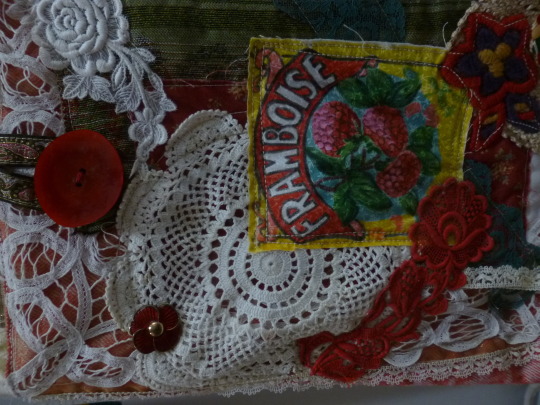
D’Iside Bag - collage of lace, embroidery, crochet and buttons, 2019.
Summer is inseparably connected with ice cream and sorbets which are a quintessential part of the season but it may come as a surprise to some that semi-frozen desserts were being enjoyed in certain areas of Europe over 300 years ago. Following to culinary history Marco Polo brought back the notion of water ices and frozen confections in the thirteenth century when he returned to Venice from his trip to China. Others say that Cathérine de Medici introduced it to France when she relocated to marry King Henry II. Neither tale is likely to be true, it is difficult to say whether water ices were first made in Italy, France or Spain. Italians were masters in developing methods of chilling and freezing drinks into sorbets and granitas. There is a special place, the Gelato Museum Carpigiani near Bologna, Italy, dedicated to the history, the culture, and the technology of ice cream made by craftsmen, a precious heritage passed over in the course of centuries.
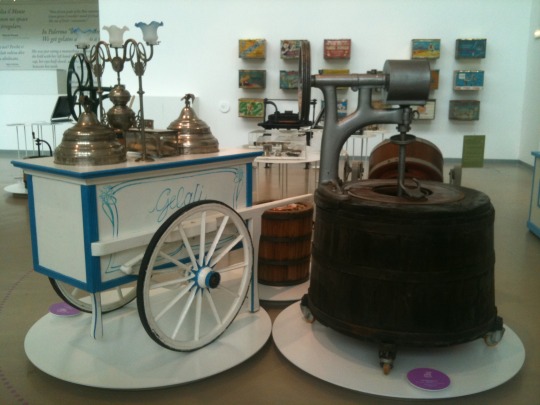
Gelato Museum Fondazione Carpigiani, Anzola Emilia (Bologna)
The 17th century saw ice drinks being made into frozen desserts. With the addition of sugar, the more commonly known “sorbet” was created. In 1686, Francesco Procopio dei Coltelli, of Sicilian origin, opened the first café, Le Procope, in Paris. The establishment became a meeting place for many famous intellectuals and ice cream lovers, including Benjamin Franklin, Diderot, Balzac,Victor Hugo and Napoleon. The café introduced gelato, the Italian version of sorbet, to the French public. In England the first known recipe for dairy based ice cream was discovered in the diary of Lady Anne Fanshawe, an English biographer, who in 1668 named her recipe “Icy cream”, a mixture of an astonishing number of ingredients such as orange blossom water, mace and ambergris. But do you know the flavors of ice cream at Jane Austen’s times?
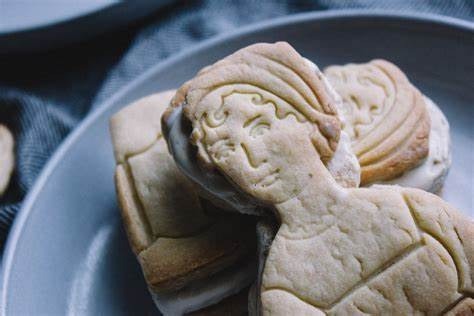
Lavender Earl Grey ice cream sandwiches à la Jane Austen
Driven by the thirst for transversal knowledge which unites international history with Italian present, artist and artisan Silvia Zambarbieri, under her brand name “D’Iside” began her research in the field of ice cream production last summer for a special project created by Design for Everyday Life and curated by Elisabeth Vermeer. “Ice Cream Poetry” is a project for poets and artists inspired by ice-cream to join an international community of ice cream lovers that exhibit their poems and artworks in our topic focused exhibitions. As usual, also in this case, Zambarbieri looked up history books, archives, made plenty of sketches and drawings of ice cream cones and sundaes and transformed these later into embroidery and patchwork patterns in small scale on cloth.
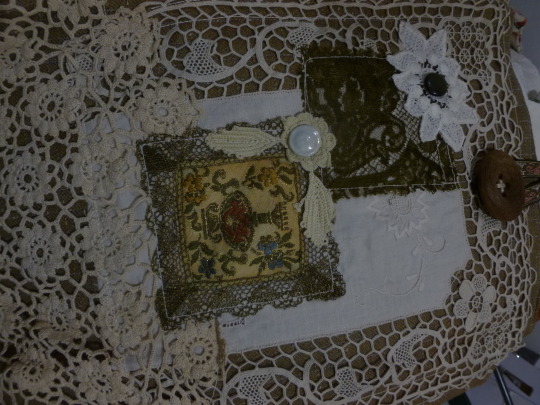
D’Iside Bag Collage of several materials, lace, crochet, eyelet and buttons, 2019.
She planned a totally inedited series of objects dedicated to ice-cream entitled “Glace-à-porter”, a play on words conceived by Elisabeth Vermeer who is a convinced promoter of Zambarbieri’s art and fashion design. The objects represent colorful and witty mini-bags with a certain capacity of hosting small necessities like a wallet and a mobile phone. Each bag is a unique piece, exclusively handmade and signed by D’Iside. The materials she uses for her collection range from bouclé yarns to jacquard, from cotton sateen to fresco wool. The bag itself is embellished with an appliqué under the shape of an opulent ice cream cone or a sundae. Mostly her “Glace-à-porter” bags reveal a reference to a drawing or a painting by American artist Wayne Thiebaud, born in Arizona in 1920.
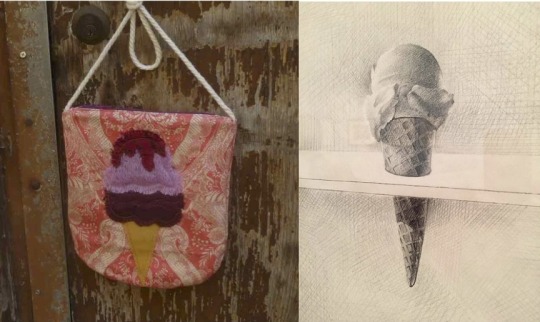
D’Iside Bag in jacquard fantasy. Shoulder strip in rough drawstring. Ice cream cone patchwork of different materials like wool, bouclé, jacquard, 2020. Wayne Thiebaud, Ice Cream Cone, 1964.

Wayne Thiebaud, Ice cream Painting. D’Iside Bag in cotton. Shoulder strip in rough drawstring. Ice cream cone patchwork in various materials like cotton “fantasy”, and vintage tablecloth, 2020.

D’Iside Bag in cotton satin. Shoulder strap in cotton and linen drawstring. Wafer pod: patchwork of several cotton pieces “fantasy”, 2020. Wayne Thiebaud Sundae.
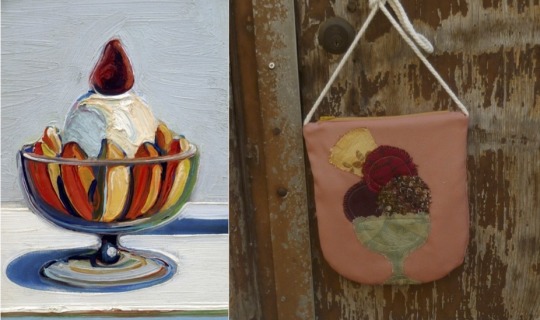
Painting by Wayne Thiebaud, Museum Voorlinden, Wassenaar. D’Iside Bag in Fresco wool. Shoulder strap in rough drawstring. Ice cream sundae: application of various materials like cotton, bouclé, jacquard, 2020.
On the occasion of the hundredth anniversary of Thiebaud’s birth it is a pleasure to remember his unmistakable heavy pigments and exaggerated colors and the well-defined shadows. The Museum Voorlinden was the first European museum to organize an exhibition around the artist. Famous for his mouthwatering depictions of cakes, ice creams and hot dogs, Thiebaud has placed the American everyday life at the core of his artistic practice. On the other hand, in the framework of fashion design, Silvia Zambarbieri, excellent observer of human attitudes in various fields and of the evolution of fashion as a telltale way of expressing ourselves, manifests the intelligent strategy to apply her utmost refined tailoring skills in beautiful but practical objects for everyday life.
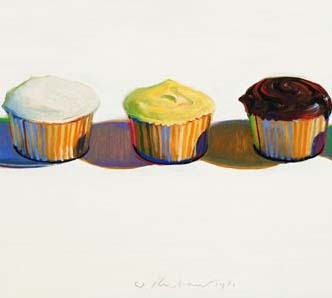
In the end of our travel through the history of ice cream and its translation into contemporary design thanks to Silvia Zambarbieri, we return to the importance of light in textile design and in painting, in memory of artist Wayne Thiebaud who wrote: “In the shadow all the light happens.”
Postscriptum: if you are interested to be part of our ice-cream project, send your poems or the photos of your artworks to the address [email protected].
#wayne thiebaud#designforeverydaylife#diside#florentine artisans#ice-cream and poetry#ice-cream history#made in italy#gelato museum#slow couture#parole spalancate
1 note
·
View note